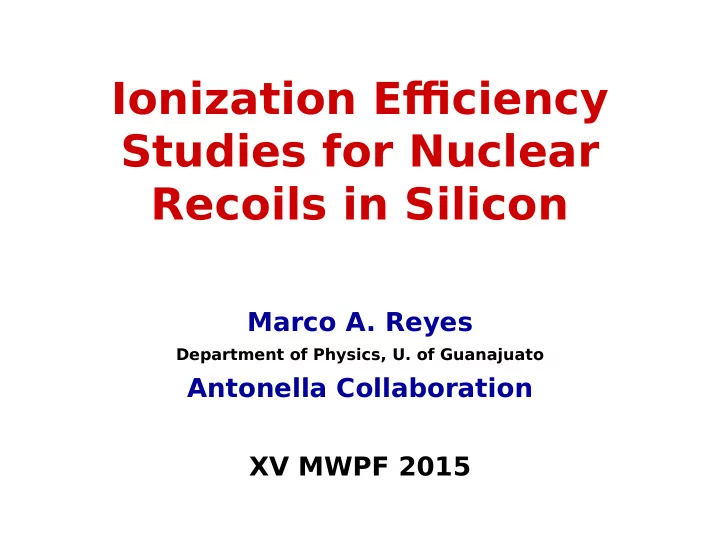

Ionization Effjciency Studies for Nuclear Recoils in Silicon Marco A. Reyes Department of Physics, U. of Guanajuato Antonella Collaboration XV MWPF 2015
Abstract The Damic Collaboration has set up an experimental array of Charge-Coupled Devices (CCDs) in a nickel mine, and has developed all analysis tools to discern any known trace of conventional matter from what a DM particle could produce when crossing the CCDs. In order to calibrate the signals from these CCDs, scientists in the Antonella Collaboration have designed experiments to quantify neutron-silicon interactions, assuming that neutrons can mimic DM interactions in the CCDs. Here we present preliminary results from the analysis of data obtained in these experiments, in particular, the measurement of ionization effjciencies in Silicon and a plastic scintillator.
CCD operation
Ionization effjciency studies • Damic CCD's measure ionization energy • Nuclear recoil energy from DM-Si interaction Ionization effjciency in Si AND Ionization effjciency in plastic scintillator Antonella Collaboration • Prove Lindhard's model (1963) Exp: 1990
Antonella experiment Target may be SiDet or a scintillator
PMT's characterization T o characterize the signal in a PMT, the experimental setup consisted of two scintillator bars, with a PMT at each end of the bars 115M 6
Scintillator EJ200 Experimental setup at FTB facility
ADC distributions The ADC distributions may be calculated using a continuous approach, or a discrete approach Gaussians x P , x 0 , σ 0 x 1 , σ 1 NIM A 451 (2000) 623 R.Dossi et al. Methods for precise PE counting with PMT s (LEDs) x n =nx 1 , σ n 2 =nσ 1 2 8
ADC distributions Charge distributions with two paper masks: one tiny hole of 0.035 mm in radius, and two small holes of 1.19 mm radius
TDC distributions p f ( t ) = exp[ − ( t − t 0 ) / τ s ] − exp[ − ( t − t 1 0 ) / τ f ] { } + τ s − τ f p exp[ − ( t − t 0 ) / τ 3 ] − exp[ − ( t − t 0 ) / τ f ] 2 { } τ 3 − τ f Histogrs: TDC for selected ADC bar Lines: normalized TDC prediction 10
Antonella at UND
Detector We used an X-ray detector which is a Silicon Drift Diode, 29mg mass
Ionization effjciency
Callibration: Fe source Systematic uncertainty dominated by the X-ray detector linear response
Scientifjc run Took data for 10 day ∼ 10 6 gamma+neutron hits in silicon detector Trigger rate ∼ 170 Hz (of which ∼ 4 Hz real particles hitting the silicon detector) 1.5 × 10 8 triggers, mostly noise from the silicon detector 1.8 × 10 5 events, after requesting hit in a Bar (PMT in coincidence) 5.1 × 10 3 events, after timing and no-saturation cuts (reject gamma prompt)
Antonella data
Antonella data
Preliminary results
Conclusions Scintillator+PMT response was studied Antonella's results: best measurement on Si IE up to date Ongoing analysis on scintillator IE
N-Si collisions
Backup slides
Antonella DAQ
Antonella DAQ
Recommend
More recommend